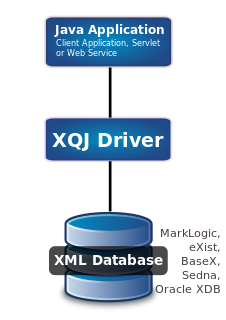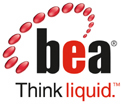This page is based on this
Wikipedia article Text is available under the
CC BY-SA 4.0 license; additional terms may apply.
Images, videos and audio are available under their respective licenses.
A transaction symbolizes a unit of work performed within a database management system against a database, and treated in a coherent and reliable way independent of other transactions. A transaction generally represents any change in a database. Transactions in a database environment have two main purposes:
- To provide reliable units of work that allow correct recovery from failures and keep a database consistent even in cases of system failure, when execution stops and many operations upon a database remain uncompleted, with unclear status.
- To provide isolation between programs accessing a database concurrently. If this isolation is not provided, the programs' outcomes are possibly erroneous.
The Web Services Business Process Execution Language (WS-BPEL), commonly known as BPEL, is an OASIS standard executable language for specifying actions within business processes with web services. Processes in BPEL export and import information by using web service interfaces exclusively.
A distributed transaction is a database transaction in which two or more network hosts are involved. Usually, hosts provide transactional resources, while the transaction manager is responsible for creating and managing a global transaction that encompasses all operations against such resources. Distributed transactions, as any other transactions, must have all four ACID properties, where atomicity guarantees all-or-nothing outcomes for the unit of work.
Web Services Security is an extension to SOAP to apply security to Web services. It is a member of the Web service specifications and was published by OASIS.
WS-ReliableMessaging describes a protocol that allows SOAP messages to be reliably delivered between distributed applications in the presence of software component, system, or network failures.
Tuxedo is a middleware platform used to manage distributed transaction processing in distributed computing environments. Tuxedo is a transaction processing system or transaction-oriented middleware, or enterprise application server for a variety of systems and programming languages.
Developed by AT&T in the 1980s, it became a software product of Oracle Corporation in 2008 when they acquired BEA Systems.
Tuxedo is now part of the Oracle Fusion Middleware.
Secure Electronic Transaction (SET) is a communications protocol standard for securing credit card transactions over networks, specifically, the Internet. SET was not itself a payment system, but rather a set of security protocols and formats that enabled users to employ the existing credit card payment infrastructure on an open network in a secure fashion. However, it failed to gain attraction in the market. VISA now promotes the 3-D Secure scheme.
Secure Electronic Transaction (SET) is a system for ensuring the security of financial transactions on the Internet. It was supported initially by Mastercard, Visa, Microsoft, Netscape, and others. With SET, a user is given an electronic wallet and a transaction is conducted and verified using a combination of digital certificates and digital signatures among the purchaser, a merchant, and the purchaser's bank in a way that ensures privacy and confidentiality
The Global XML Web Services Architecture (GXA) was an announcement by Microsoft in 2002 of several proposals for extensions to SOAP. Some of the components of GXA were developed into standards in combination with other companies, including IBM. Others were specific to Microsoft and have been superseded. Microsoft released a reference implementation of a part of GXA as Web Services Enhancements 1.0 SP1 for Microsoft .NET (WSE).
In Online transaction processing (OLTP), information systems typically facilitate and manage transaction-oriented applications.
In computing, the X/Open XA standard is a specification released in 1991 by X/Open for distributed transaction processing (DTP).
In computer science and engineering, transactional memory attempts to simplify concurrent programming by allowing a group of load and store instructions to execute in an atomic way. It is a concurrency control mechanism analogous to database transactions for controlling access to shared memory in concurrent computing.
Transactional memory systems provide high-level abstraction as an alternative to low-level thread synchronization. This abstraction allows for coordination between concurrent reads and writes of shared data in parallel systems.
Transactional NTFS is a component introduced in Windows Vista and present in later versions of the Microsoft Windows operating system that brings the concept of atomic transactions to the NTFS file system, allowing Windows application developers to write file-output routines that are guaranteed to either succeed completely or to fail completely.
Major operating system components, including System Restore, Task Scheduler, and Windows Update, rely on TxF for stability. During the development of Windows Vista, WinFS also relied on TxF for storing files.
The Microsoft Distributed Transaction Coordinator (MSDTC) service is a component of modern versions of Microsoft Windows that is responsible for coordinating transactions that span multiple resource managers, such as databases, message queues, and file systems. MSDTC is included in Windows 2000 and later operating systems, and is also available for Windows NT 4.0.
Web Services Composite Application Framework (WS-CAF) is an open framework developed by OASIS. Its purpose is to define a generic and open framework for applications that contain multiple services used together, which are sometimes referred to as composite applications. WS-CAF characteristics include interoperability, ease of implementation and ease of use.
Web Services Interoperability Technology (WSIT) is an open-source project started by Sun Microsystems to develop the next-generation of Web service technologies. It provides interoperability between Java Web Services and Microsoft's Windows Communication Foundation (WCF).

Apache Axis2 is a core engine for Web services. It is a complete re-design and re-write of the widely used Apache Axis SOAP stack. Implementations of Axis2 are available in Java and C.
Web Service Atomic Transaction is an OASIS standard.
To achieve all-or-nothing property for a group of services, it defines three protocols, and a set of services. These protocols and services together ensure automatic activation, registration, propagation and atomic termination of web services. The protocols are implemented via the WS-Coordination context management framework and emulate ACID transaction properties.

XQuery API for Java (XQJ) refers to the common Java API for the W3C XQuery 1.0 specification.



